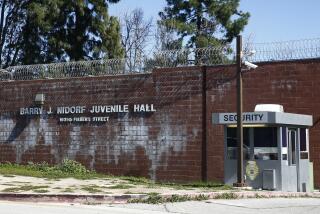Library System Faces Cutbacks to Make Up for Cash Shortage
SANTA ANA — Without more money, Orange County’s troubled library system will need to reduce both its hours and its budget for books by about a third, according to a report released Wednesday.
The study said the library system could save money if it became independent of the county, but that modest increases in property taxes still might be needed to avoid cutbacks.
The report, prepared for the county by David M. Griffith & Associates, seeks to assess the future of the 27-branch system. It comes as city and county leaders debate whether to break up the system into several regional districts or form an independent authority to operate the libraries.
The study examined a variety of possible governing structures, including formation of north and south county library systems or simply allowing cities to run the libraries within their boundaries.
But the report said the most cost-effective strategy would be to keep the system intact under a new structure such as a joint powers authority run by the cities. Operating costs could be reduced by $1.7 million if the libraries were removed from the county’s administrative structure, the study found.
To prevent additional cutbacks, the property tax assessment paid by residents would have to be increased by $8 to $10, the study found. An increase of $18 to $21 would allow officials to enhance services.
Residents now pay about $14 a year for county library service. By contrast, San Francisco residents pay $36 and Newport Beach residents pay more than $50.
The financial crisis has its roots in the state’s 1991 decision to balance its budget by cutting the amount of property tax revenues received by special districts such as the library system.
The library system’s budget already has shrunk from $27 million to $22 million since then, and could shrink another $5 million by the end of the decade, according to the report.
By then, the system will face a budget shortfall of nearly $5 million, the consultants said. That gap must be closed either through service cuts or new revenue.
Without more money, the county might be forced to reduce library hours by about 30%, close some branches and cut annual expenditures for books, periodicals and other materials by up to 40%.
“Over time, the impact would be magnified as aged items [are] not replaced in the collection and the entire collection [becomes] more restricted in scope,” the report stated.
The prospect of another round of budget cuts alarmed city officials and library patrons, though the idea of raising tax assessments drew mixed reactions.
“The cuts already have been terrible. I just can’t imagine them cutting more.” said Westminster Councilwoman Margie Rice. “I don’t think more taxes are the answer.”
But several library users said they would be willing to contribute more.
“It’s a small price to pay,” said community college student L.J. Pham, who uses the Garden Grove Regional Library. “I think the citizens of this county . . . care about education and libraries.”
The county bankruptcy exacerbated the situation by forcing the Board of Supervisors to discontinue a modest subsidy to the libraries.
The cash shortage forced reductions in staff, hours and book purchases and to increase fines and fees.
The system’s budget is $22 million, but its base revenue totals about $18 million. The remaining $4 million comes from reserves that will run out by 1997.
(BEGIN TEXT OF INFOBOX / INFOGRAPHIC)
Growing Divide The county library system, its budget cut from $27 million to $22 million during the last three years, faces an additional $5-million shortfall by the end of the decade. If more money is not found, library hours and service will have to be severely cut. Here is a look at the system’s projected financial situation, amounts in thousands:
*--*
Revenue Costs Deficit 1995-96 $16,603 $19,748 $3,144 1996-97 17,012 20,480 3,468 1997-98 17,431 21,238 3,807 1998-99 17,917 22,506 4,589 1999-20 18,359 23,339 4,980
*--*
Source: David M. Griffith & Associates study for County of Orange
More to Read
Sign up for Essential California
The most important California stories and recommendations in your inbox every morning.
You may occasionally receive promotional content from the Los Angeles Times.











